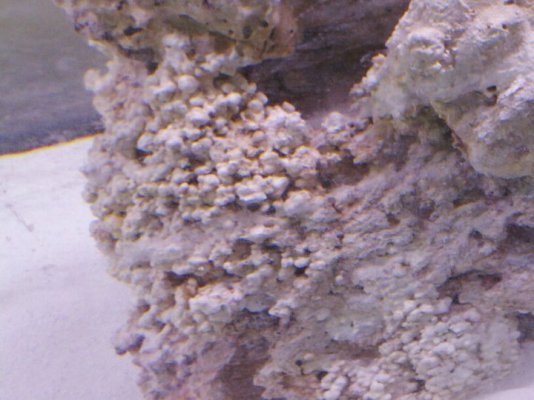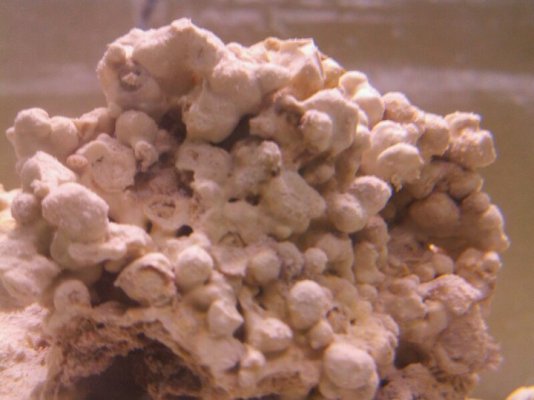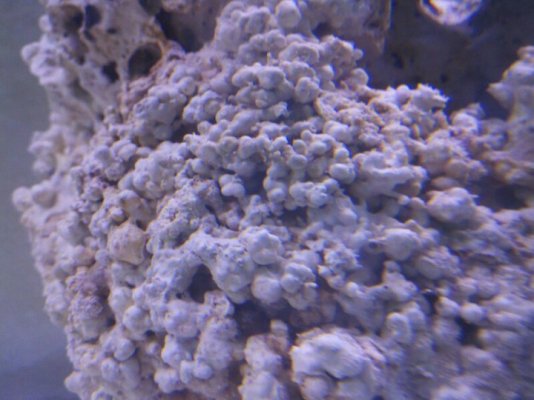You are using an out of date browser. It may not display this or other websites correctly.
You should upgrade or use an alternative browser.
You should upgrade or use an alternative browser.
White lumps on Liverock?
- Thread starter uscamaro
- Start date
The friendliest place on the web for anyone with an interest in aquariums or fish keeping!
If you have answers, please help by responding to the unanswered posts.
If you have answers, please help by responding to the unanswered posts.
Jaybird
Aquarium Advice FINatic
I was loking at the picture and I can't see anything in it other than clean, bare, rock. What area of the photo are you referring to?
Ziggy953
Aquarium Advice Addict
I don't see what you are talking about either. Can you edit the pic and circle the area you are talking about?
Ziggy953
Aquarium Advice Addict
I expect that is the rock itself?? Have you touched them to see if it is solid like the rock or soft and mushy?
Jaybird
Aquarium Advice FINatic
If you are referring to the roundish parts on the pictures of the rocks then it is just the rocks themselves.
Ziggy953
Aquarium Advice Addict
Well you have to keep in mind that some of the "rocks" we buy to put in our tanks are not really rocks at all. They are the skeletons of old corals.
Definitely just the rock though
Definitely just the rock though
Before moving the rocks around I noticed this little green guy (about 3/4"). The only thing green anywhere near the tank is the slight coraline algae on another rock. Any ideas?
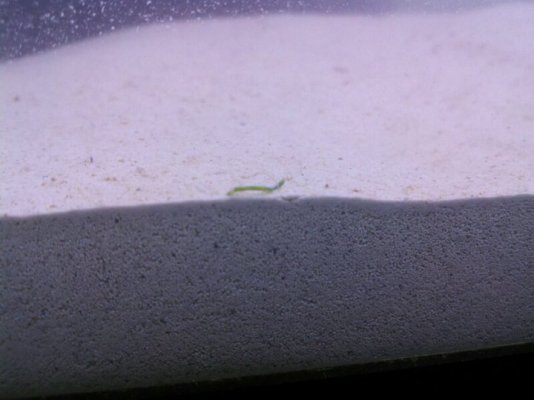
Then when further inspecting another rock I noticed these purple pods all over the top and red spots at the bottom.
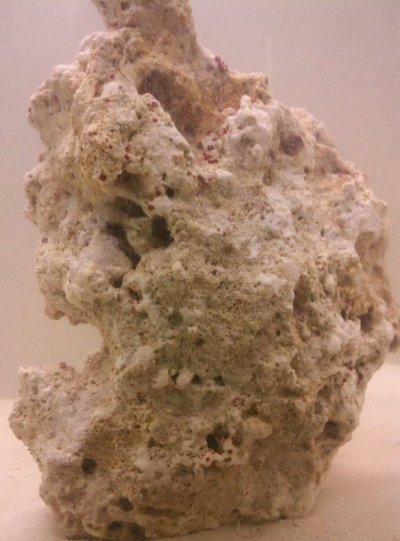
The purple pods were all different sizes. They were softer than the rock, but it didn't look like coraline (from pictures I've seen).
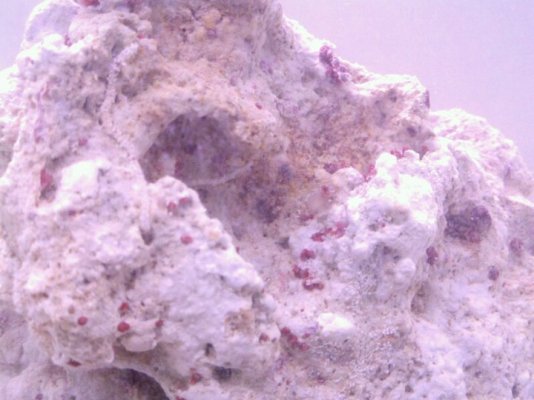
Towards the bottom there was a small cluster of red dots. I know the colors in the pictures don't match up, but it's the best my phone can do.
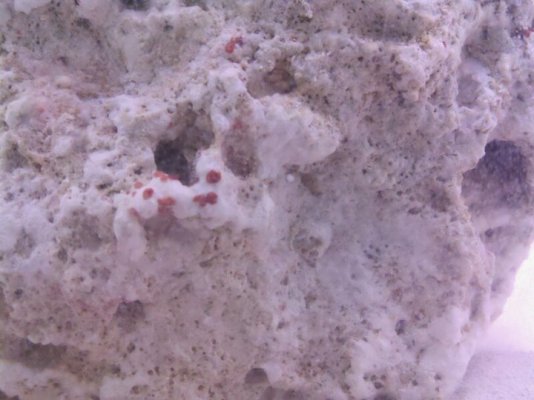

Then when further inspecting another rock I noticed these purple pods all over the top and red spots at the bottom.

The purple pods were all different sizes. They were softer than the rock, but it didn't look like coraline (from pictures I've seen).

Towards the bottom there was a small cluster of red dots. I know the colors in the pictures don't match up, but it's the best my phone can do.

Last edited:
Thanks for the clarification that it was a rock. Lol, I felt like a big wimp when I was moving things around. I was hesitant to touch anything for fear I would kill it, ruin something awesome, or I'd get hurt by some freak water-bug that only lived in my rock!
iDream
Aquarium Advice Addict
green thing looks like a piece of macro algae, does it move or look like a piece of plant?
i've never heard of green worms. and as for the red spots it looks like coralline to me, it is red sometimes, most of my rock had red coralline
i've never heard of green worms. and as for the red spots it looks like coralline to me, it is red sometimes, most of my rock had red coralline
0o.Kelsey.o0
Aquarium Advice Addict
It all looks like normal growth for rocks..probably just an algae of some sort. The rock does not look very live though...looks more like dry base rock. Maybe your LFS ripped you off, are you sure it is liverock?
It all looks like normal growth for rocks..probably just an algae of some sort. The rock does not look very live though...looks more like dry base rock. Maybe your LFS ripped you off, are you sure it is liverock?
As sure as a beginner can be. The other two pieces I got from the same large tank are live because I can see coraline growth. This piece has a few things growing on it, but I could be wrong. If it's the color that's making you skeptical, it could be sand soot. My tank was cloudy for a while because I didn't rinse the sand very well; so when I put my hand in there, it got really cloudy again from the sand and leftovers on the rock.
Is there a sure-fire way to know if it's base/live rock?
Jaybird
Aquarium Advice FINatic
Usually live rock will not be as clean as what you have in the pictures. Usually there is a lot of coraline growth, maco algae, pods, worms, etc. Base rock is usually much, much less expensive than live rock. The only sure fire way to know will be when you cycle the tank. Live rock will take a lot less time in cycling the tank than dry rock will. This is due to the established bacteria on the rocks.
The sand will settle down with time. Give it a month or two and it will not be so easily disturbed
The sand will settle down with time. Give it a month or two and it will not be so easily disturbed
Then when further inspecting another rock I noticed these purple pods all over the top and red spots at the bottom.
View attachment 26383
The purple pods were all different sizes. They were softer than the rock, but it didn't look like coraline (from pictures I've seen).
View attachment 26381
Towards the bottom there was a small cluster of red dots. I know the colors in the pictures don't match up, but it's the best my phone can do.
View attachment 26382
I have those things in my refugium. I think mine are foraminifera, homotrema rubrum. If you do an image search on it, you can compare.
I found this description online - It's by Ron Shimek:
Some of the most abundant forams that are found in our aquaria are spectacular. They are large and obvious and are often exceptionally abundant. And, unlike the remainder of the forams discussed in this article, they are not found in the sediments. As they don't look like anything else in our systems, they are often misidentified as small sponges, hydrocorals or stony corals. These foraminiferans belong to a peculiar foram species called Homotrema rubrum and it has a shell that may be orange, but is more typically hot pink or bright cherry red. The red coloration is due to an iron salt that is incorporated into the skeleton. Found growing on hard surfaces such as rocks, the calcareous shell looks like a small hydrocoral or a hard, spiky crystal with angular projections. Homotrema seldom get larger than an eighth or quarter of an inch in height, but their brilliant color renders them very obvious. They feed on particulate material in the tank's water, probably mostly bacterial aggregates they catch in fine filamentous protoplasmic strands which extend from the tips of the angular projections. There are similar white foraminiferan species found in aquaria. Their bodies look like small "spiky" versions of a stony coral, rather like nano-sized versions of bird's nest coral, Seriatopora hystrix. These foraminiferans have not been identified to species.
mr_X
Aquarium Advice Addict
you cannot see bacteria. i don't know how you can tell if that rock is live or not from a picture.It all looks like normal growth for rocks..probably just an algae of some sort. The rock does not look very live though...looks more like dry base rock. Maybe your LFS ripped you off, are you sure it is liverock?
if it was sitting in the store sump for a year, it would be white like that, but it would also be "live".
ShawnMMcKenna
Aquarium Advice Regular
It looks like Fiji live rock to me.
Similar threads
- Replies
- 8
- Views
- 581
- Replies
- 5
- Views
- 405
- Replies
- 8
- Views
- 584

